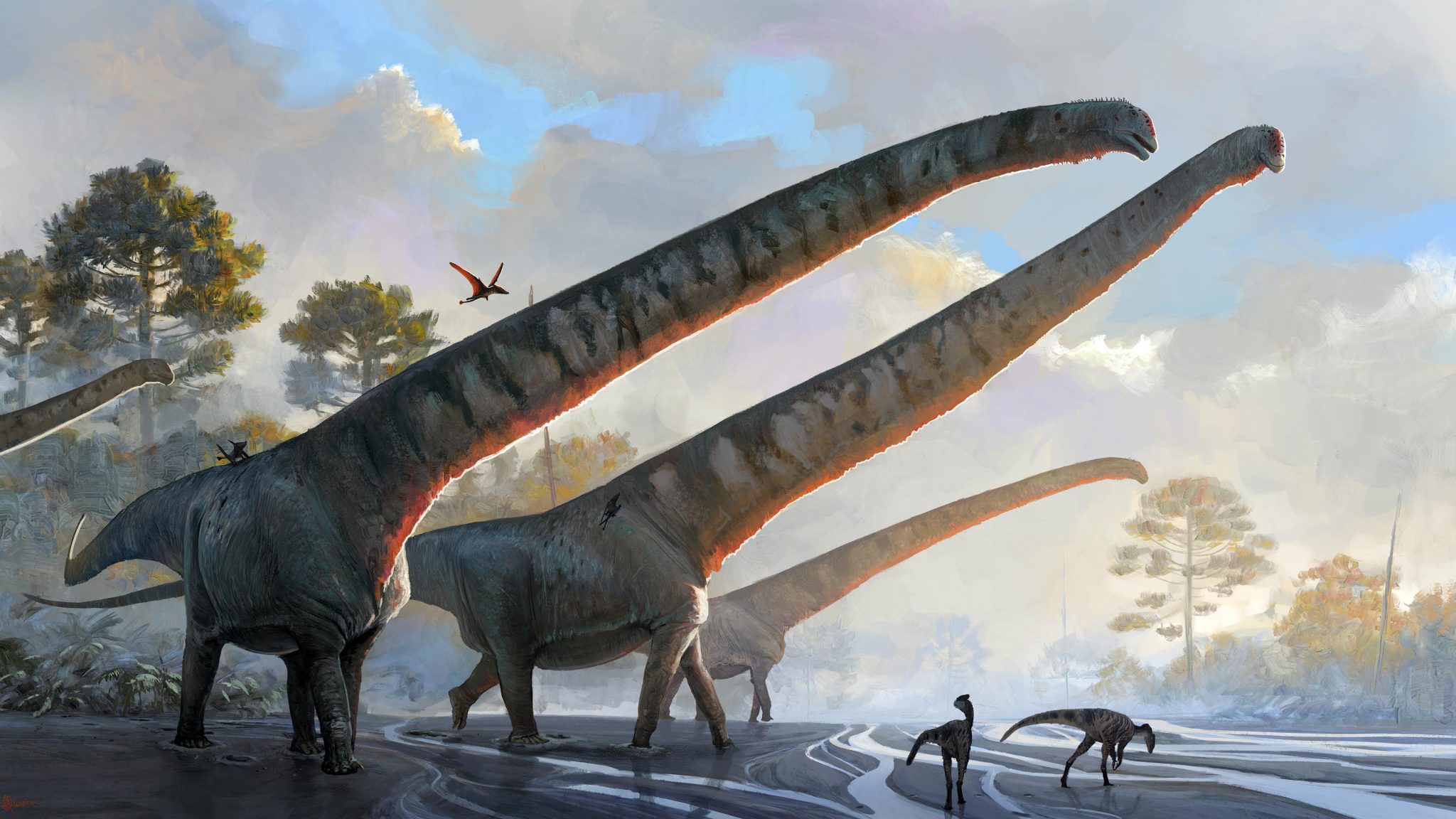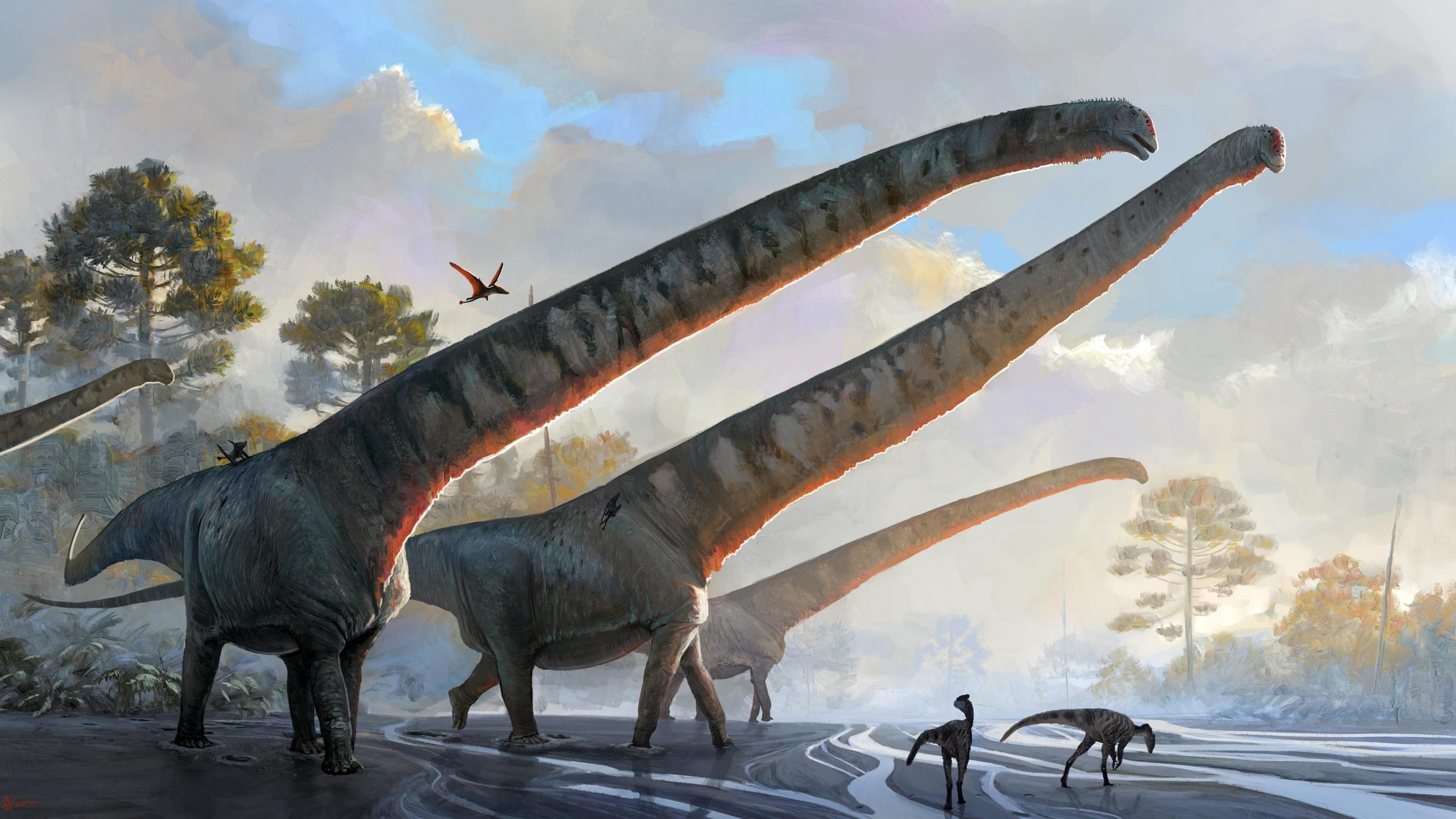
Eine Ausstellung des als Mamenchisaurus sinocanadorum bekannten Sauropoden, der 15 Meter lang war. Bildnachweis: © Julia d’Oliveira
Mit ihren langen Hälsen und massiven Körpern haben Sauropoden-Dinosaurier die Fantasie der Menschen beflügelt, seit Ende des 19. Jahrhunderts in den Vereinigten Staaten die ersten relativ vollständigen Fossilien entdeckt wurden. Das Originalexemplar im Besitz des Museums für Naturkunde Debbie Es war unter diesen Entdeckungen.
Jetzt berichtet ein internationales Team unter der Leitung des Paläontologen Dr. Andrew J. Moore von der Stony Brook University, einschließlich Professor Paul Barrett, verdienstvoller Forscher, vom Natural History Museum in London, dies[{“ attribute=““>Jurassic Chinese sauropod known as Mamenchisaurus sinocanadorum sported a 50-foot (15-meter) long neck.
The revelation comes as part of a paper that aims to document the diversity and evolutionary history of the family Mamenchisauridae, a group of particularly long-necked sauropod dinosaurs that roamed East Asia and possibly other parts of the world from the Middle Jurassic to the Early Cretaceous (approximately 174–114 million years ago).

Lower jaw and two of the vertebrae linked together. Credit: Trustees of the Natural History Museum
Mamenchisaurus sinocanadorum was discovered in approximately 162-million-year-old rocks from the Xinjiang Uyghur Autonomous Region of northwest China in 1987 by the China–Canada Dinosaur Project team, for which it was named in 1993. At approximately 15.1 meters, its neck was more than six times longer than the necks of giraffes and 1.5 times the length of a double-decker bus! This potentially makes it the longest neck of any animal to have ever existed.
For sauropods, the long neck was one of the keys to achieving large body size. To power such a large body, sauropods had to be efficient at gathering food, and that’s exactly what a long neck was built for. A sauropod could stand in one spot and graze the surrounding vegetation, conserving energy while taking in tons of food. Having a long neck probably also allowed sauropods to shed excess body heat by increasing their surface area, much like the ears of elephants. This lifestyle was exceptionally successful with the sauropod lineage appearing early in dinosaur evolutionary history and persisting until the final days of the Mesozoic, when an asteroid wiped out most of the dinosaurs, except for the relatives of modern birds.

Lower jaw and two of the vertebrae linked together. Credit: Trustees of the Natural History Museum
The question of which sauropod had the longest neck is not a simple one to answer. The largest sauropods tend to be some of the most poorly known as it is very hard to completely bury such a large animal in sediment, the first stage required for fossilization. Poor preservation of these specimens and their closest relatives often makes estimates of their neck length speculative.
Although Mamenchisaurus sinocanadorum is known only from a handful of bones from the neck and skull, the research team was able to reconstruct its evolutionary relationships and thus make comparisons to the unusually complete skeletons of its closest relatives. This allowed them to conclude that Mamenchisaurus sinocanadorum had a neck approximately 15.1 meters long, the longest of any known sauropod.
Lead author Dr. Andrew J. Moore, Stony Brook University paleontologist, said, “All sauropods were big, but jaw-droppingly long necks didn’t evolve just once.
“Mamenchisaurids are important because they pushed the limits on how long a neck can be and were the first lineage of sauropods to do so. With a 15-meter-long neck, it looks like Mamenchisaurus sinocanadorum might be a record-holder – at least until something longer is discovered.”

Prof Paul Barrett studying the Mamenchisaurus sinocanadorum specimen in the Paleozoological Museum of China in Beijing. Credit: Trustees of the Natural History Museum
The question of how sauropods managed to evolve such long necks and large bodies without collapsing under their own weight has puzzled scientists since their discovery. When studying Mamenchisaurus the team was able to use computed-tomography (CT) scanning to reveal that the vertebrae were lightweight and hollow with air spaces comprising about 69–77% of their volume, similar to the lightly built skeletons of birds. However, such featherweight skeletons would also be more prone to injury. To combat this Mamenchisaurus had 4-meter-long rod-like neck ribs, bony extensions of the vertebrae that created overlapping bundles of rods on either side of the neck. These bundles would have stiffened the neck of Mamenchisaurus sinocanadorum, increasing its stability.
The remaining mystery of Mamenchisaurus and many other long-necked sauropods is understanding just how they drew air down these long necks all the way to their lungs.
Prof. Paul Barrett, Merit Researcher, Natural History Museum London explains, “Like all other sauropod dinosaurs, Mamenchisaurus had a complex breathing apparatus that included not only the lungs, but also numerous balloon-like air sacs. These were connected to the lungs and windpipe but spread throughout the interior of the animal’s neck, chest, and abdomen.
“Taken in combination, these air sacs had a much greater volume than the lungs, and they even went inside the bones, hollowing them out. This extra space would have helped these gigantic sauropods to move the large volume of air in the lengthy windpipe that would have occupied their extraordinary necks.”
While Mamenchisaurus sinocanadorum is now thought to have the longest neck of any dinosaur it was still not the biggest dinosaur. That title is held by a species in the titanosaur group and dinosaur fans will get the chance to see the colossal titanosaur Patagotitan mayorum, one of the largest known creatures to have ever walked our planet, this summer at London’s Natural History Museum.
Reference: “Re-assessment of the Late Jurassic eusauropod Mamenchisaurus sinocanadorum Russell and Zheng, 1993, and the evolution of exceptionally long necks in mamenchisaurids” by Andrew J. Moore, Paul M. Barrett, Paul Upchurch, Chun-Chi Liao, Yong Ye, Baoqiao Hao and Xing Xu, 15 March 2023, Journal of Systematic Palaeontology.
DOI: 10.1080/14772019.2023.2171818
The new paper Re-assessment of the Late Jurassic eusauropod Mamenchisaurus sinocanadorum Russell and Zheng, 1993, and the evolution of exceptionally long necks in mamenchisaurids is published in the Journal of Systematic Palaeontology. The research was funded by numerous organisations including the United States National Science Foundation, The Royal Society of London, and the National Natural Science Foundation of China.

„Musikfan. Sehr bescheidener Entdecker. Analytiker. Reisefreak. Extremer Fernsehlehrer. Gamer.“








More Stories
Neue Forschungen zu einer massiven Überschiebung deuten darauf hin, dass das nächste große Erdbeben unmittelbar bevorstehen könnte
Tag und Nacht sprühen Funken, während SpaceX den Start einer Starship-Rakete vorbereitet
Identische Dinosaurier-Fußabdrücke auf zwei Kontinenten entdeckt